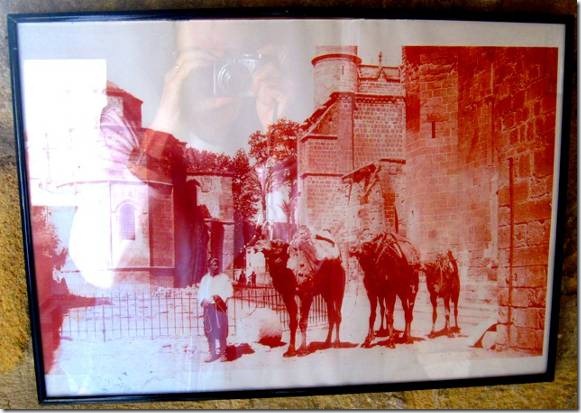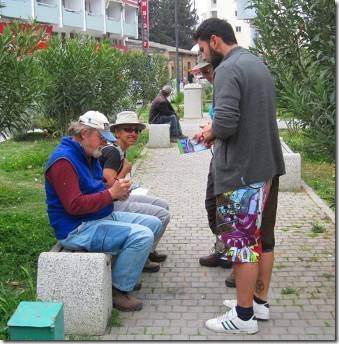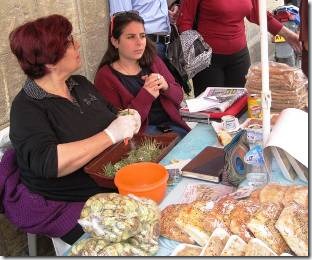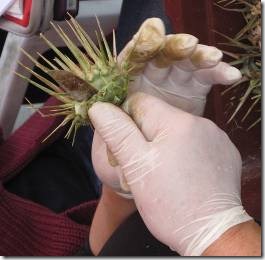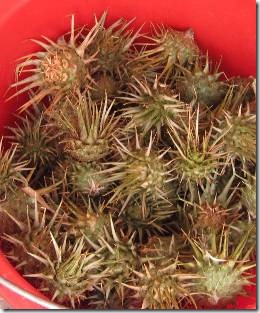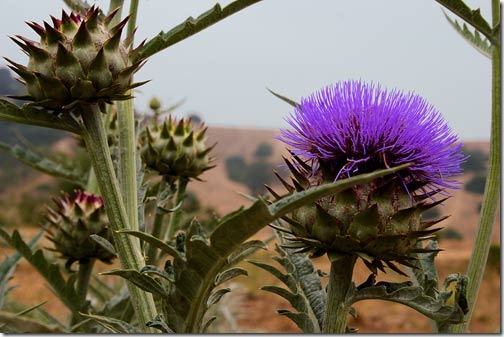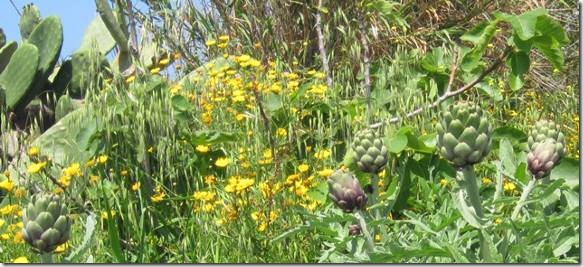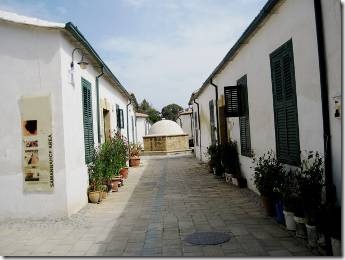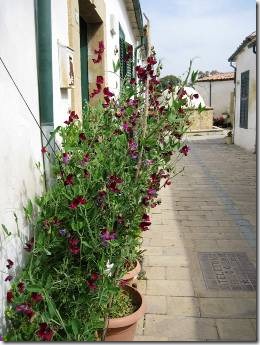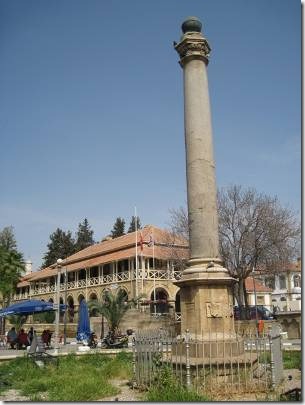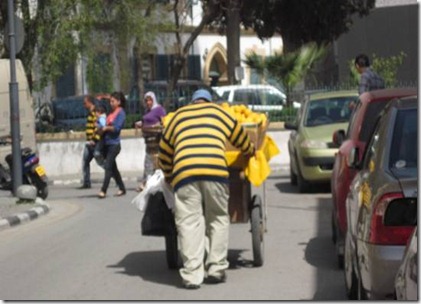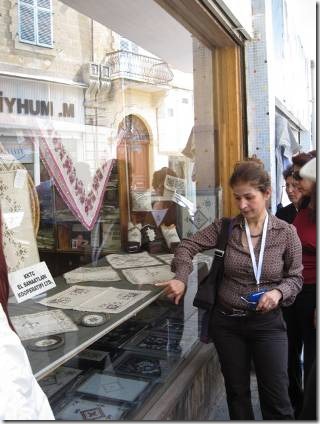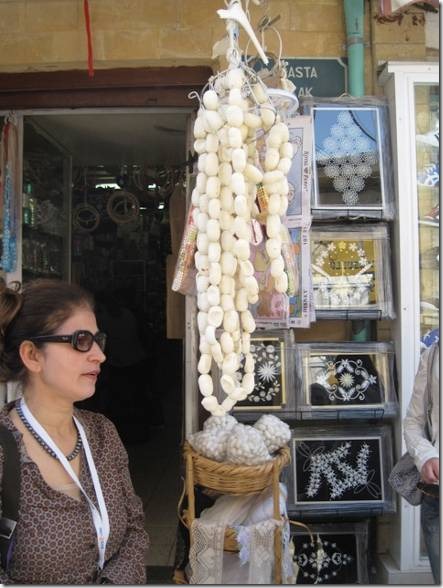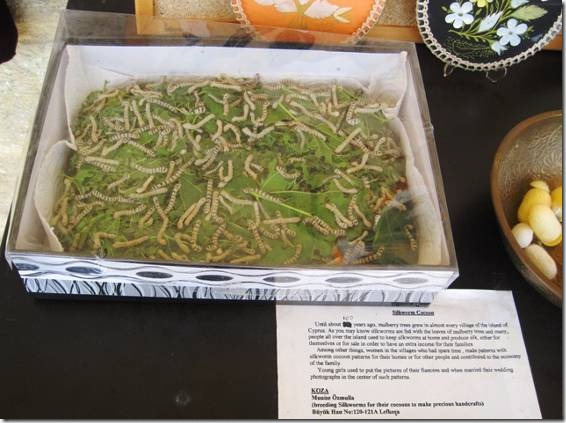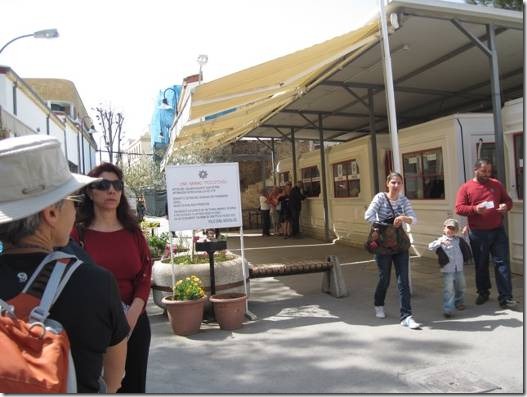On Friday April 6th we drove off to Nicosia for the free two hour tour. Today is April 18th so what I remember of the tour are the bits and pieces interesting to me. We had a wonderful tour guide who’d had to explain everything twice, once in Turkish and once in English for our mixed group. I was happy to catch a word of Turkish here and there during the Turkish version. While writing this email I tried to learn a bit more about some of what we saw. Here is part one.
Ru
Nicosia Tour
http://www.cypnet.co.uk/ncyprus/city/nicosia/index.html about Nicosia/Lefkoşa history and culture.
http://www.heiditrautmann.com/category.aspx?CID=8762668225 Heidi Trautmann writes about the artistic soul of the city.
The Cyprus Tourist Guides Association (KITREB),supported by the Finance and Tourism Ministry and the Antiquities and Museums Department are offer free tours of the old city of Nicosia three times a week.
The two hour tour guides visitors through the walled city of Lefkosa, the Mevlevi Museum, Samanbahce Houses, the Venetian Column, Dervis Pasa Mansion, the Great Inn, Selimiye Mosque, Bedestan, Lapidary Museum, Eaved House, Arasta and many other historical landmarks.
These city tours are being held with the aim of assisting tourists interested in learning more about the history of the old city of Nicosia, and are organized in conjunction with similar tours of South Nicosia.
Tours are held on Mondays, Wednesdays and Friday, starting at 10.00 in front of the Tourist Information Office at the Kyrenia Gate, and 10.30 at the Lokmaci crossing point. Just turn up in time; no booking required. http://www.kyrenia.towntalk.net/events/d/37453/free-city-tour-lefkosa/
We left the marina extra early, arrived in Nicosia, found a parking space and a coffee place, all in time to meet the tour at the Kyrenia Gate at 10 am.
Old photos in the upstairs room of the Kyrenia Gate (probably called that because you went north from the gate in the direction of Kyrenia…or so Randal says.)
Did we meet at UMass?
A future tour guide, Cypriot by birth, you’d think him a Brit by his speech. But he reminded me of freshman year at UMass. Unfortunately for him he was assigned the task of translating everything our tour guide Selin said from Turkish into English. Too much, too fast, too hard and he eventually gave up, took his leave, so Selin had to give the tour in both languages.
Right off the bat we passed these women selling pastries and wild artichoke.
The intriguing artichoke; I might have to try some. Like shucking oysters.
Ready to eat
Wild artichoke are quite lovely though some countries have declared them noxious weeds! http://pizzabytheslice.com/urban-landscaping-nature-jacaranda-artichoke-thistles.htm
http://feralkevin.com/?p=219 shows how to harvest, cook, and eat it which I found quite interesting.
These were growing on the road I walk to my Turkish lessons at DEKS but look different than the wild artichoke sold in Nicosia.
Samanbahce Houses
These courtyard homes also fascinated me so I did some research. If you are approved to live in one of the homes, you live there as long as you want with no increase in rent. But when you leave anyone living with you must leave and then apply as a new renter.
Abstract
Traditional historic urban quarters, which are special places not only due to the cultural heritage that they house but also due to their urban pattern, are in danger of losing their traditional character, if relevant measures fail to exist to ensure the continuity of this character.
Just like the island of Cyprus as a whole, as being ruled by many different conquerors, the Walled City of Nicosia, which is the core of the capital of the island, has undergone substantial changes throughout history, to fit the requirements of different cultures. As a spatial reflection of different socio-economic life or attitude of the rulers – Lusignan (1192-1489); Venetian (1489-1571); Ottoman (1571-1878); British (1878-1960) – the urban pattern as well as the buildings and their functions have been modified through time. Consequently, the traditional historic areas became places of intermingling cultures.
Samanbahce, a unique traditional residential area at the edge of the Kyrenia Avenue in the Walled City of Nicosia, is a unique place not only due to its distinctive physical, urban and architectural characteristics, but also as being the first mass-housing area on the Island developed in 1930’s by the British. Although being located next to the most lively area of the Walled City, today, Samanbahce area is suffering from physical and social decay.
The aim of this paper is to propose conservation and revitalization measures to address the deterioration and obsolescence process of Samanbahce area, based on a thorough study at both architectural and urban levels. The method of the analysis will include a field and a questionnaire survey, which will convey to an understanding of the environmental and socio-cultural qualities.
The Samanbahçe residential district is the first mass-housing in Cyprus developed during the British Period in 1930’s by Evkaf (Foundation). Originally, these houses were built to cover the needs of low-income families, with an understanding of “social housing developments”…… During the British period, some new functions have been introduced into the City which attracted population from rural areas to Nicosia. Accordingly, in order to answer the increasing demand for housing generated by this migrating population, some mass social housing projects have been implemented in certain parts of the City. Samanbahçe is first of all these new implications. According to the records, the group of attached terrace-houses built in similar dimensions were originally called “Şaban Paşa Houses” (Andız, 1990). Having been built at once at a particular time in an organic layout dating back to the Ottoman period, the area shows a distinguished characteristic with its planned layout.
REVITALIZING A DECLINING RESIDENTIAL AREA – SAMANBAHÇE – IN THE WALLED CITY OF NICOSIANaciye Doratlı, Assist. Prof. Dr.
Şebnem Hoşkara, Assoc. Prof. Dr.
İbrahim Numan, Prof. Dr.
ftp://ftparch.emu.edu.tr/Projects/cycities/…/E29-hoskaradoratlinumaniaps.doc
Atatürk Square
Everybody and his brother had a hand at the structures and symbols of the column and buildings in the square, the Brits being the most recent before Cyprus became independent, had the most lasting impact though the column (moved from Salamis) was originally erected by the Venetians, one time rulers of Cyprus.
Wonder what team they belong to?
He reminded me of a giant bumble bee pushing a cart of oranges along the street. But when I looked at the photo later I noticed the other man wearing the exact same shirt.
Our guide, Selin, explaining about the traditional lace made by the Cyprus Women’s Cooperative
“Lefkara lace is one of the handicrafts for which Cyprus is well known all over the world. There are several, and sometimes conflicting, versions of how this famous handicraft became part of Cyprus’ heritage. According to tradition, handwoven local fabrics were used to apply the lace in the early days, but they were eventually replaced by imported linens from countries such as France and Ireland. The traditional colors of thread used for Lefkara lace are green and beige. The price of the lace is determined by the intricacy of the design as well as the size of the pattern. Different motifs have different names such as Daisy, River, etc. Lefkara lace is also fashioned into pillows.
The origin of Lefkara lace dates to the island’s Venetian period. One tradition holds that the families of Venetian nobles who lived in Lefkara village during the summer months used the local labor force to fashion intricate lace for use in their homes. The ladies from the noble families taught local ladies the techniques of Italian lace making, but over the years the locals adapted this their own style and taste. Today, Lefkara lace still maintains some similarities with Italian lace, but its style has been greatly altered over the years.
Some believe that Leonardo da Vinci visited the island and ordered Lefkara lace to be taken back to a cathedral in Italy, after which the Italians adapted the lace to their unique style. No one knows which story is true, but either way, Lefkara lace has been produced on Cyprus for centuries.”
http://www.trnc.eu/Arts___Culture.html
Selin explaining about the silkworm cocoon art.
Silk weaving and silk cocoon decoration in North Cyprus
“Up until recently, the landscape around the villages of Karava and Lapithos in North Cyprus was dotted with mulberry trees, food for hungry silk worms. Lapta and Hisarkoy were the most important villages for silk production. Every Turkish Cypriot household would take part in taking the precious silk worm cocoons, spinning out the thread and then weaving fine silk cloth. Unfortunately, the silk cloth trade in North Cyprus died out due to foreign competition, but one fascinating craft remains, North Cyprus silk cocoon decoration.
Intricate silk pictures from North Cyprus
Thanks to a government initiative, Turkish Cypriots have flocked to classes teaching this traditional craft in North Cyprus. The white silk cocoons, about the size of a plum, now come from the Karpas peninsula. Silk cocoons are quite firm to the touch, enabling each cocoon to be cut open and folded out flat, like a piece of card. Intricate shapes are then cut from this flattened cocoon and sewn onto velvet, sometimes held in place with tiny beads.” http://www.cyprus44.com/culture/handicrafts.asp
“No country is better adapted for silk culture than Cyprus, where the
mulberry-tree grows in great luxuriance to the altitude of 5000 feet,
and the warmth and dryness of the climate is highly favourable to the
silkworm. There is no tax upon the mulberry, and should artificial
irrigation be encouraged by the government, this tree should be
generally planted throughout the Messaria and all other districts, and a
special impulse should be directed to silk development. Formerly the
production of silk was an important export to France, but of late years
it has decreased to a mere bagatelle. In the spot where I am now writing
there are numerous mulberries in a profusion of rich foliage sufficient
for the production of two pounds of silk by each tree; but they are
entirely neglected, and the same depression in the silk cultivation may
be remarked throughout the island.”
Cyprus, as I Saw It in 1879 / Baker, Samuel White, Sir, 1821-1893 http://infomotions.com/etexts/gutenberg/dirs/etext03/cyprs10.htm
The Ledra Gate Crossing between North and South Cyprus.
This is where we crossed back and forth when we went with Rob and Julia last February to do our Visa run. I took a photo before I thought better of it.

